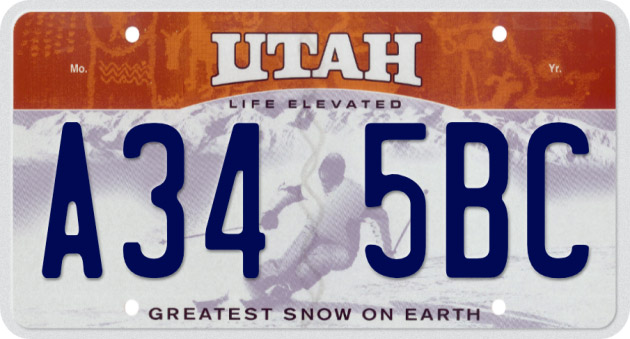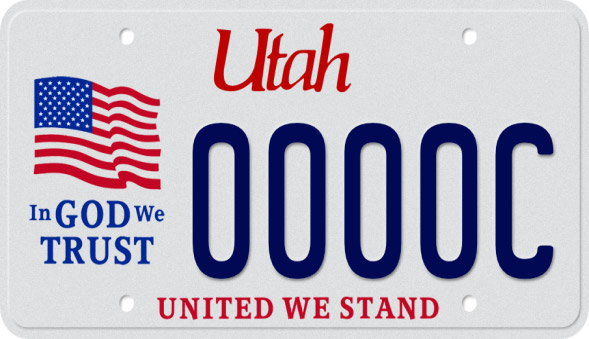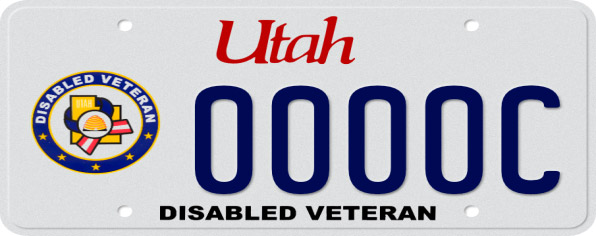 What Is a License Plate Reader and Can Police Track You Using It?
What Is a License Plate Reader and Can Police Track You Using It?
Table of Contents
- Utah License Plates
- Utah License Plate Design and Formats
- Utah Vanity License Plate
- Most Popular Utah Special Plate Numbers
- Utah License Plate Lookup
- What Do I Need to Get a License Plate in Utah?
- Differences Between a Passenger License Plate and a Commercial License Plate in Utah?
- How to Renew License Plate in Utah
- How to Transfer a License Plate in Utah
- Utah License Plate Lookup Frequently Asked Questions (FAQ)
 Utah License Plates
Utah License Plates
Utah license plates are metallic plates assigned to vehicles registered in the state that serve as a form of identification for these vehicles. The Utah State Tax Commission issues these license plates through its Division of Motor Vehicles (DMV). They display a combination of numbers and letters, collectively referred to as a license plate number, which is unique to each vehicle and links it to its registered owner, primarily for law enforcement, taxation, and other administrative purposes. Per the Utah Motor Vehicle Act, these license plates must be displayed on every motor vehicle that operates in the state – this includes automobiles, RVs, trailers, sedans, SUVs, semitrailers, trucks, vans, and motorcycles. Motorcycles, trailers, and semitrailers are typically issued a single license plate to be displayed on the rear, while all other vehicles are currently issued two identical plates to be displayed on the front and the rear. However, following the passing of SB 45 (2024), the state will drop this two-plate requirement by January 1st, 2025.
The Utah DMV issues a variety of license plates for registered vehicles. These plates can be grouped into three main categories:
- Standard Issue Plates: these are the standard plates issued to vehicle registrants. Standard issue plates are currently available in four variants – "In God We Trust", "Life Elevated Skier", "Life Elevated Arches", and "Off-Highway Vehicle". Note that previous versions of these standard-issue plates are still valid for use on vehicles.
- Special Group Plates: these plates raise money for specific causes or honor certain groups – these groups or causes are typically indicated on the plate. You may be required to meet certain eligibility criteria to obtain these plates. Many special group plates can also be personalized.
- Exempt Plates: these are issued to publicly owned vehicles or ones leased by public entities.
You will typically be issued two registration decals with your license plates - a month decal and a year decal indicating the month and year of your vehicle registration's expiration date, respectively. These decals must be affixed to your rear license plate in designated locations (on the plate).
 Utah License Plate Design and Formats
Utah License Plate Design and Formats
Utah license plates are rectangular plates made from reflectorized aluminum material displaying a five or six-character license plate number at the center and the state name at the top of the plate. The specific background design of these plates varies based on the plate type:
- In God We Trust plates have a plain basic design featuring dark blue serials over a white background; however, the state name is written in red. The national flag is at the left of the plate, and the phrase "In GOD We TRUST" is screened underneath it. The phrase "UNITED WE STAND" is also screened below the plate number.
- Life Elevated Skier plates feature dark blue serials on a skier graphic design background. The state name is screened in white inside a brown-colored band at the top of the plate, with the phrase "LIFE ELEVATED" screened directly beneath it. 'GREATEST SNOW ON EARTH" is also screened at the bottom of the plate.
- Life Elevated Arches plates feature dark blue serials on a Delicate Arch graphic design background, with the phrase "LIFE ELEVATED" screened at the bottom of the plate.
- Special Group plates have a similar design to the "In God We Trust" plates. However, a logo or emblem of the specific cause or organization being represented is featured on the left of the plate (just before the plate number), and a descriptive phrase for this cause/organization is included at the bottom.
Here are pictorial representations of these license plate designs:
Standard issue plates:


Special Group plates:


* Source: Utah Division of Motor Vehicles
 Utah Vanity License Plate
Utah Vanity License Plate
Vanity license plates, or personalized plates, are special license plates where the vehicle owner can choose the combination of letters or numbers that make up their license plate number. The number of characters allowable for these personalized plates depends on the plate and vehicle type. Standard issue Life Elevated Skier and Life Elevated Arches plates allow up to seven characters, while In God We Trust and Special Group plates allow only five. Similarly, motorcycle plates can only be customized with up to five characters. The chosen customizations for personalized plates must be within specific guidelines set by the Utah Division of Motor Vehicles, such as:
- Special punctuation signs and symbols, like commas, hyphens, question marks, periods, and exclamation marks, are not permitted
- The requested customization must not be offensive to good taste, decency, or misleading. This includes combinations that reference drugs or drug paraphernalia, genitalia, sexual acts, or express contempt or ridicule for another individual or group of people
- The requested combination of letters and numbers must be unique and cannot match any currently registered license plate. Additionally, it should not conflict with any series or the letter/number combinations used on standard-issue license plates
You can request personalized plates from the Utah DMV online via its Motor Vehicle Portal; this portal also allows you to check the availability of your desired customization. You can also order these plates in person at your local DMV office or by mailing an Application for Personalized and Replacement License Plates, along with the necessary fees, to
Division of Motor VehiclesVehicle Compliance Services
P.O. Box 30412
Salt Lake City, UT 84130
The plate type determines the cost of obtaining personalized plates; you will also be charged an annual $10 fee in addition to your registration renewal fees. The DMV typically ships approved personalized plates to a designated mailing address (as listed on your motor vehicle records) within eight weeks. However, your application fees will be refunded if your application is not approved and the plates aren't issued. Be aware that you will lose your personalization rights if you fail to renew your personalized plates within six months of expiration.
 Most Popular Utah Special Plate Numbers
Most Popular Utah Special Plate Numbers
The Utah DMV offers over 70 special group plates allowing vehicle owners to express their affiliation with or support for various causes and organizations. Some of the most popular themes and designs for these special group plates are:
- Historic Black and White
- Collegiate
- Wildlife
- Military and Veteran
- Charitable Organization
- Special Cause/Awareness
 Utah License Plate Lookup
Utah License Plate Lookup
A license plate lookup is a method used to access information on a vehicle using its license plate number. This information includes details like the vehicle's make, model, year, title status, odometer readings, brand history, salvage history, and maintenance records. License plate lookups are used for various reasons, such as:
- To obtain a detailed history report before purchasing a vehicle
- To gather information about vehicles involved in accidents
- To identify suspicious vehicles, aid in recovering stolen vehicles, and gather information for similar law enforcement investigations and legal proceedings
In Utah, motor vehicle records are considered "protected" and typically only released to specific individuals, including the subject of the record, their authorized representative, law enforcement personnel, and others designated by law. Eligible parties can access these records by subscribing to the state's Title, Lien and Registration Service (TLR) platform for a $125 annual fee. A separate $2 fee is also charged per record requested. Requests for motor vehicle records can also be made by submitting a Release of Protected Motor Vehicle Information (Form TC-890) to the DMV, along with the stipulated fees. Be aware that Utah specifically denies requests for access to motor vehicle records if the obtained information is to be used for debt collection, skip tracing, or asset recovery purposes.
You also have the option of utilizing third-party websites like RecordsFinder to perform reverse license plate number searches online. These websites typically offer basic information but may charge a nominal fee for detailed information.
Utah Reverse License Plate Number Search
You can get vehicle-related information online using license plate lookups and reverse license plate number searches. These methods offer similar results but have different approaches. A license plate lookup requires the complete and accurate license number to retrieve information about the linked vehicle. However, a reverse license plate number search allows you to find the license plate associated with a vehicle and other pertinent details by providing partial information on the vehicle, like its make, model, and description.
Third-party websites like RecordsFinder offer reverse license plate search services for Utah-registered vehicles. Note that your search results will only include information allowed by federal and state motor vehicle records privacy laws.
 What Do I Need to Get a License Plate in Utah?
What Do I Need to Get a License Plate in Utah?
Utah license plates are issued by the state's Division of Motor Vehicles and can only be obtained for vehicles appropriately registered with this division. Be aware that this registration is mandatory for Utah residents; new residents to the state are allowed 60 days to transfer their out-of-state title and registration to the DMV, where applicable. You will typically need the following documents to register your vehicle with the DMV:
- The vehicle title. If the vehicle has not been titled, you will need to complete a Vehicle Application for Utah Title (Form TC-656) and submit a Certificate of Inspection (Form TC-661). The latter is mandatory for all vehicles being titled in Utah for the first time, excluding new vehicles sold by a Utah dealer
- Your most recent registration
- Utah emission certificate (this is only required for certain vehicles registered in Salt Lake, Davis, Utah, Weber, and Cache counties)
- Utah safety inspection certificate, where applicable
- A valid government-issued ID
- Applicable fees. These fees vary depending on your vehicle type, age, fuel type, purchase price, county of residence, and applicable local and state taxes
You can initiate the vehicle registration process in person at any local DMV office. It is advisable to contact these offices beforehand to confirm their business hours, determine whether an appointment is needed, and also get specific information on required documentation and fees for registering your vehicle. License plates are typically issued after applications are successfully processed; the timeline for this is usually determined by the completeness of your application and the DMV's workload (at the time of your application).
Inquiries concerning vehicle registration and license plate issuance in Utah can also be directed to the DMV at (800) 368-8824.
 Differences Between a Passenger License Plate and a Commercial License Plate in Utah?
Differences Between a Passenger License Plate and a Commercial License Plate in Utah?
Under Utah law, commercial vehicles are vehicles used to transport people or goods for payment or profit as a hired carrier or to transport the owner's goods or property to support their own business. Common examples of commercial vehicles include trailers, apportioned trucks, semi-trailers, buses, and truck tractors. Similarly, passenger vehicles are vehicles used for personal or leisure purposes. These typically include sedans, pickup trucks, SUVs, hatchbacks, and minivans.
The registration requirements for commercial and passenger vehicles are generally the same. However, the DMV may issue specific license plates for commercial vehicles with slight differences from those issued for passenger vehicles to indicate their vehicle type and weight class.
The table below summarizes the key differences between license plates issued for private vehicles and ones issued for commercial vehicles in Utah:
| Features | Passenger License Plate | Commercial License Plate |
|---|---|---|
| Vehicle Use | Personal/private use and transportation | For business use and transporting goods or passengers for profit |
| Plate number arrangement |
Five or six-character alpha-numeric combination depending on plate type (for standard-issue plates, with"A12 3BC" or "1ABC2" serial format * serial format for special group, exempt, and personalized plates may differ |
Seven-character alpha-numeric combination with "123456A" or "A123456" serial format |
| Design & Color |
"In God We Trust", "Life Elevated Skier", and "Life Elevated Arches" available with plate-specific background designs and features. * special group plates typically utilize the plain white background of "In God We Trust" plates with an organization or cause-specific logo included |
Typically issued with "Life Elevated Skier", and "Life Elevated Arches" background designs. |
| Vehicle Types | Cars, SUVs, vans, personal trucks, etc. | Trailers, semitrailers, truck-tractors, etc. |
| Requirements for obtaining |
|
Same as passenger license plates. Vehicles weighing over 55,000 pounds typically have to provide a Heavy Vehicle Use Tax (Form 2290). |
 How to Renew License Plate in Utah
How to Renew License Plate in Utah
Utah vehicle registration is typically valid for one year and must be renewed with the state's Division of Motor Vehicles (DMV). Renewing this registration automatically revalidates your license plates. Note that the division may offer a six-month registration period for vehicles weighing 12,000 pounds or less, including motorcycles. Notwithstanding this, you must renew your registration by midnight of the last day of its expiration month (as indicated on the month decal issued with your license plates or last renewal), regardless of your registration validity period. If the registration period ends on a day when state or county offices are closed, the vehicle registration is extended until midnight of the next business day.
You can renew your Utah vehicle registration via any of the following methods:
- Automatic Renewals. The DMV offers automatic renewals to registrants who enroll for this option either through its Motor Vehicle Portal or by submitting an Automatic Registration Renewal Application (Form TC-505). Once enrolled, you'll receive an email notification from the DMV about your upcoming registration renewal. This notice will include any required inspections and deadlines. On the scheduled date, the DMV will verify inspections and process payment. You'll receive an email confirmation and receipt once your renewal is complete. Your registration and decal will be sent to your address on file. Note that you must provide bank account details for automatic payment when signing up for automatic renewals
- Online Renewals through the state's Renewal Express platform. You will need your renewal notice or previous registration, a valid credit card, and necessary inspection certificates to utilize this option
- In-Person Renewals. You can renew your registration in person using a DMV-authorized On-The-Spot Renewal Station near you or by visiting your local DMV office. It is advisable to contact this office beforehand to schedule an appointment
- Postal Mail Renewals. You can renew your registration by sending the necessary renewal documentation (and fees, made payable to the Utah State Tax Commission) to the DMV at:
P.O. Box 30412
Salt Lake City, UT 84130
You can also contact your local DMV office to determine whether they accept mail-in renewals.
Registration renewals can be initiated 60 days before your registration expiration date. The DMV typically mails postcard reminders during this timeframe but recommends that registrants sign up for email reminders to avoid having their postcards get lost in the mail. These postcards usually indicate information like your registration expiration date, necessary inspections, additional actions that may need to be taken before you can renew your registration, and required renewal fees. You can also access this information online via the division's renewal information portal. You will typically be issued a new registration card and registration decals after your renewal is successfully processed. Note that the timeline for this varies by location and renewal method.
 How to Transfer a License Plate in Utah
How to Transfer a License Plate in Utah
The Utah DMV allows for the transfer of license plates from one vehicle to another under certain conditions. These include:
- The transfer application is in the name of the plates' original owner unless the owner's name changed due to marriage, divorce, or a court order
- The new vehicle does not require a different registration period from the old vehicle (that originally had the plates)
- The license plates are not lifetime trailer plates
Utah license plates may also be transferred between individuals when a vehicle is sold or traded, assuming the original owner includes the license plate in the sale, trade, or release of ownership and the new owner applies to transfer the license plate during vehicle registration.
Visit your local DMV office to transfer your license plates. Inquiries on plate transfers can also be directed to the division at (800) 368-8824. Be aware that transferring Utah license plates between vehicles without the explicit approval of the state's DMV is a class C misdemeanor, punishable by up to 90 days in jail and fines of up to $750.
 Utah License Plate Lookup Frequently Asked Questions (FAQ)
Utah License Plate Lookup Frequently Asked Questions (FAQ)
Can I Get a Replacement for My Lost License Plate in Utah?
You can replace lost license plates, decals, or registration cards in Utah by ordering replacements online via the DMV's Motor Vehicle Portal or visiting your local DMV office. You will typically be required to provide either a copy of your most recent registration, your license plate number, or Vehicle Identification Number (VIN) and pay a replacement fee. This fee is determined by the specific item being replaced and can range from $4 for registration replacement only to $20 or more for replacing special group plates.
What Do Police See When They Run Your License Plates in Utah?
Local, state, and federal law enforcement officials typically have access to all kinds of vehicle-related information when they run a Utah license plate. These include:
- The vehicle's registration status
- The vehicle owner's name, picture, and contact information
- The vehicle owner's driver's license status
- Open warrants
- Stole vehicle alerts, BOLOs, and other alerts
What Is the Penalty for Driving with an Expired License Plate in Utah?
Utah license plates must be renewed by midnight on the last day of their validity period or the next business day if the expiration date falls on a weekend or holiday. This validity period is typically 12 months, but it may be six months for vehicles that do not weigh more than 12,000 pounds. The expiration month is typically indicated on the month decal the DMV issues along with the plate (as well as for subsequent plate renewals).
Driving with expired license plates in Utah is an infraction, punishable by fines of up to $750. You might also be subject to additional penalties, like late renewal fees and vehicle impoundment.
Do I Need to Return License Plates in Utah?
Per state law, you must return your plates to the DMV within 20 days after you sell or trade your car if you did not include them as part of the sale/trade and don't wish to transfer them to another vehicle. You will also have to surrender your Utah license plates to the division if it cancels, suspends, or revokes them for any reason.
Can I Keep My Utah License Plate If I Move to Another State?
There are no laws mandating you to return your Utah license plates if you move out of state. Nevertheless, it is advisable to return these plates to the DMV once you receive new ones from your new state of residence to avoid the plates being fraudulently used if they end up missing. Be aware that you may be required to surrender these plates if the DMV cancels, revokes, or suspends your registration.
What Size Are License Plates in Utah?
Utah license plates typically measure 12 inches by 6 inches; however, plates assigned to motorcycles measure 7 inches by 4 inches.
How Long Can You Drive with Temporary License Plates in Utah?
The Utah DMV may issue temporary permits allowing vehicle owners to operate their vehicles before they get their registration and license plates. These temporary permits typically range from 96 hours to 60 days; the DMV determines the actual validity for requested temporary permits based on the specific situation for which they are required. Temporary permits can be requested in person at your local DMV office. You can also contact this office for alternative methods to obtain these permits.
Driving with an expired temporary permit is considered an infraction in Utah. This offense carries a statutory penalty of up to $750 in fines, and additional sanctions may also be incurred.
What Are the Steps to Renew a License Plate in Utah?
You can renew your Utah license plates by doing the following:
- Determine your registration expiration date. This is usually the last day of the month indicated on your month decal (issued along with the plate and for subsequent renewals)
- Complete all required inspections
- Gather necessary renewal documents
- Initiate the renewal. The DMV offers online, in-person, and mail-in renewal options. You can also opt for the division's auto-renewal service
- Receive new registration card and decals
- Affix the new month and year decals to your vehicle
What Do I Do If My License Plate Is Lost or Stolen in Utah?
You should visit your local DMV office to notify them that your license plate has been lost or stolen and obtain a replacement. You can also order replacement plates online via the division's Motor Vehicle Portal. You will have to provide documentation like your most recent registration (a copy), your license plate number, or your VIN and pay a replacement fee determined by the plate type and specific items being replaced.
In addition, it is advisable to notify your local law enforcement agency if your license plates are stolen.
 Related Articles
Related Articles
The information on this website is taken from records made available by state and local law enforcement departments, courts, city and town halls, and other public and private sources. You may be shocked by the information found in your search reports. Please search responsibly.
Recordsfinder.com is not a “consumer reporting agency” and does not supply “consumer reports” as those terms are defined by the Fair Credit Reporting Act (FCRA). Pursuant to our Terms of Service and Privacy Policy, you acknowledge and agree not to use any information gathered through Recordsfinder.com for any purpose under the FCRA, including but not limited to evaluating eligibility for personal credit, insurance, employment, or tenancy.
Searches of license plate and VIN information are available only for purposes authorized by the Driver’s Privacy Protection Act of 1994 (DPPA).
By clicking “I Agree” you consent to our Terms of Service, agree not to use the information provided by Recordsfinder.com for any unlawful purposes, and you understand that we cannot confirm that information provided below is accurate or complete.
The search you are about to conduct on this website is a people search to find initial results of the search subject. You understand that any search reports offered from this website will only be generated with the purchase of the report or account registration.



